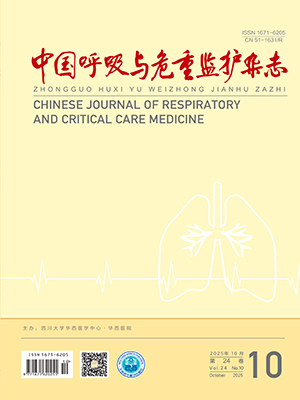| 1. |
Marik PE, Monnet X, Teboul JL. Hemodynamic parameters to guide fluid therapy. Ann Intensive Care, 2011, 1(1): 1.
|
| 2. |
Mekontso-Dessap A, Castelain V, Anguel N, et al. Combination of venoarterial PCO2 difference with arteriovenous O2 content difference to detect anaerobic metabolism in patients. Intensive Care Med, 2002, 28(3): 272-277.
|
| 3. |
Monnet X, Julien F, Ait-Hamou N, et al. Lactate and venoarterial carbon dioxide difference/arterial-venous oxygen difference ratio, but not central venous oxygen saturation, predict increase in oxygen consumption in fluid responders. Crit Care Med, 2013, 41(6): 1412-1420.
|
| 4. |
Dellinger RP, Levy MM, Carlet JM, et al. Surviving Sepsis Campaign: international guidelines for management of severe sepsis and septic shock: 2008. Crit Care Med, 2008, 36(1): 296-327.
|
| 5. |
Mesquida J, Saludes P, Gruartmoner G, et al. Central venous-to-arterial carbon dioxide difference combined with arterial-to-venous oxygen content difference is associated with lactate evolution in the hemodynamic resuscitation process in early septic shock. Crit Care, 2015, 19: 126.
|
| 6. |
Bihari D, Smithies M, Gimson A, et al. The effects of vasodilation with prostacyclin on oxygen delivery and uptake in critically ill patients. N Engl J Med, 1987, 317(7): 397-403.
|
| 7. |
Fink MP. Cytopathic hypoxia. Is oxygen use impaired in sepsis as a result of an acquired intrinsic derangement in cellular respiration?. Crit Care Clin, 2002, 18(1): 165-175.
|
| 8. |
Gattinoni L, Brazzi L, Pelosi P, et al. A trial of goal-oriented hemodynamic therapy in critically ill patients. SvO2 Collaborative Group. N Engl J Med, 1995, 333(16): 1025-1032.
|
| 9. |
Velissaris D, Pierrakos C, Scolletta S, et al. High mixed venous oxygen saturation levels do not exclude fluid responsiveness in critically ill septic patients. Crit Care, 2011, 15(4): 177.
|
| 10. |
刘兆润, 吴国刚, 张殿红.中心静脉血氧饱和度监测在重症加强治疗病房中的临床应用.中国呼吸与危重监护杂志,2011, 10(2):194-196.
|
| 11. |
Perz S, Uhlig T, Kohl M, et al. Low and "supranormal" central venous oxygen saturation and markers of tissue hypoxia in cardiac surgery patients: a prospective observational study. Intensive Care Med, 2011, 37(1): 52-59.
|
| 12. |
Chertoff J, Chisum M, Garcia B, et al. Lactate kinetics in sepsis and septic shock: a review of the literature and rationale for further research. J Intensive Care, 2015, 3: 39.
|
| 13. |
Schumacker PT, Cain SM. The concept of a critical oxygen delivery. Intensive Care Med, 1987, 13(4): 223-229.
|
| 14. |
张北源, 顾勤, 刘宁. 脓毒症患者中心静脉-动脉血二氧化碳分压差与动脉-中心静脉血氧含量差的比值和乳酸的相关性研究.中国呼吸与危重监护杂志, 2016, 15(2): 119-124.
|
| 15. |
Mallat J, Lemyze M, Meddour M, et al. Ratios of central venous-to-arterial carbon dioxide content or tension to arteriovenous oxygen content are better markers of global anaerobic metabolism than lactate in septic shock patients. Ann Intensive Care, 2016, 6(1): 10.
|
| 16. |
Garcia X, Pinsky MR. Clinical applicability of functional hemodynamic monitoring. Ann Intensive Care, 2011, 1: 35.
|




